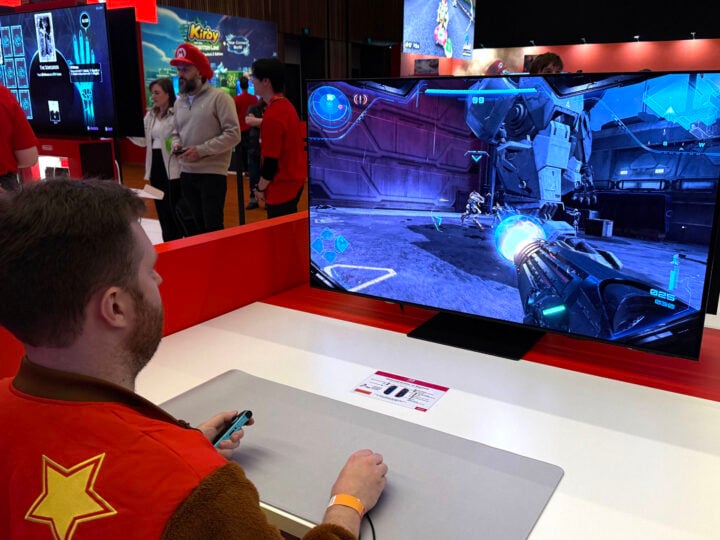Of all the new features coming to the Nintendo Switch 2, I expected its PC-like mouse controls to be something of a gimmick. Like the HD Rumble of the original Joy-Con, perhaps only a few games would use it to its full potential.
After trying the Switch 2’s mouse controls at the recent Melbourne preview event, I’m confident that it’s no mere gimmick. In fact, I think it will open up more ways to play console games that competitors will be side-eyeing with envy.
I’m not the only one who thinks this, either. My friend and colleague Alice Clarke’s impressions of the mouse controls were similarly positive at the first Switch 2 hands-on event in New York.
With a specialised attachment, the Switch 2’s Joy-Con transform from a regular controller to a mouse-like input by placing the sensor face-down on a surface. Nintendo claims that it works just as well on your lap as it does on a desk or a table.
It’s not often that a company’s claims hold up to complete scrutiny, but Nintendo is onto something here. Its unique approach to an age-old control method has me rethinking how I’ll play some of the next big games.
Wheelchair basketball action in Drag X Drive
My first encounter with the Switch 2’s mouse controls came from Drag X Drive, the stylised wheelchair basketball game. By dragging both Joy-Con across a flat surface, you mimic the physical act of wheeling a chair.
Immediately, I felt my actions replicated faithfully in the game. Spinning one wheel changed directions, while long and drawn-out motions built up speed in straight lines. To change directions even quicker, tapping one or both of the shoulder buttons applied brakes, skidding momentum to an abrupt halt.
It felt clever and a novel way of introducing the concept of the Switch 2 mouse controls. Once a three-on-three competitive game started, all muscle memory went out the window, and I floundered my way across the court like a headless chook.
Skill issues aside, I appreciated how intuitive the upgraded Joy-Con felt in its new mode. With each wheel spin, the controllers vibrated, providing real-time feedback with each push and collision (of which there were many).
The precision on show suggested to me that Drag X Drive has a decent skill ceiling that’ll unfurl once it comes out. I worry about the game’s longevity, however, considering it hinges on multiplayer, requiring everyone to own a pair of new Joy-Con. Regardless, it’s a great demonstration of how well the technology works.
Another factor that’ll contribute to not only the game’s success, but the mouse controls’ success, is player comfort. Playing Drag X Drive at a public showcase meant customisation was limited. By that I mean the desk was at an uncomfortable height, so I felt my shoulders fatiguing quickly because I was reaching out awkwardly.
I’d read similar sentiments previously from overseas reporters, like The Verge‘s Ash Parrish, who mentioned similar discomfort levels. I then tried using the Joy-Con on my lap, which worked a treat. My arms and shoulders rested in a more relaxed position, I immediately noticed a difference. I felt much less tension and stress throughout my arms and shoulders, which bodes well for longer sessions.
Switch 2 mouse controls enable PC-like precision
Drag X Drive was a strong showcase for how the Switch 2 mouse controls do something new and interesting. On the other hand, Metroid Prime 4: Beyond proved what PC players have known for a long time: first-person games play best with a mouse.
Compared to a joystick, a mouse provides more one-to-one motion with greater precision and responsiveness. Everyone has their preferences, sure, but the Switch 2 mouse controls showed directly how different the control schemes are.
Metroid Prime 4 still supports the classic console setup of two control sticks, so the option remains for stick enthusiasts. But what’s particularly impressive is the ease of swapping control methods. When using the split Joy-Con configuration, one in each hand, you can place one down in the mouse position at any moment, and the game automatically recognises the input.

It was fantastic to use in a battle against several space pirates, locking on and then moving the Joy-Con in small motions to target exactly where I wanted to aim. Good for lining up headshots, the mouse controls also made it easier to lead your shots and aim ahead of moving targets.
When using a controller, making a quick 180-degree turn is often tricky. Unless you have your aim sensitivity turned way up, that is, which then has a flow-on effect elsewhere. With the Switch 2 mouse controls, turning quickly to quickly target flanking enemies was as easy as breathing.
Even as a lifelong console gamer, I’ll likely play most of Metroid Prime 4 using mouse controls, that’s how good they felt. My only concern is similar to that presented by Drag X Drive. Comfort over a longer time remains a big question mark.
Unlike Drag X Drive, using the mouse mode on your lap doesn’t translate as well in Metroid Prime 4. Controlling a wheelchair relies on up-and-down motions, while a first-person shooter requires motion on more axes. Unless you have a big lap, it’d be easy to run out of space.
Nintendo would do well to sell branded lap desks for prolonged play sessions. I’d get one in a heartbeat if it meant enjoying the mouse controls in more comfort.
There are a bunch of third-party games taking advantage of the mouse controls too. Although I didn’t go hands-on, the Civilization 7 station looked like a smart example of bridging the gap between console and PC controls, so there’s a lot to look forward to.
The post Don’t sleep on Nintendo Switch 2’s clever mouse controls appeared first on GadgetGuy.






0 comments:
Post a Comment